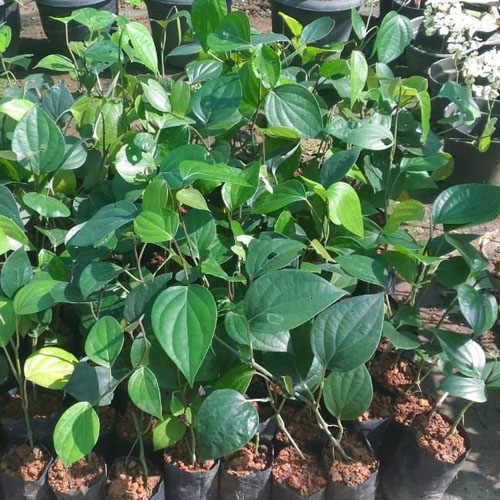Black Pepper ( Kalimirch) Plants
Black pepper, known as Piper nigrum in botanical terms, is one of the most widely used spices in the world. Here's an overview of the Black Pepper plant:
Description:
- Botanical Name: Piper nigrum
- Family: Piperaceae
- Common Names: Black Pepper, Kalimirch, Peppercorn
- Appearance: Black pepper is a perennial climbing vine that can grow up to 4-5 meters (13-16 feet) in height. It has heart-shaped leaves and small, greenish-yellow flowers that grow in spikes. The plant produces small berries, which are dried and processed to produce black pepper.
Growing Conditions:
- Climate: Black pepper thrives in tropical climates with high humidity and temperatures ranging from 20°C to 30°C (68°F to 86°F). It requires a well-defined dry season for fruiting.
- Soil: The plant prefers well-drained, loamy soil rich in organic matter. It grows best in slightly acidic to neutral soil with a pH of 5.5 to 6.5.
- Watering: Black pepper needs consistent moisture, especially during the growing season. However, it should not be waterlogged. Regular watering is essential, but proper drainage is also crucial to prevent root rot.
Cultivation:
- Propagation: Black pepper is usually propagated by stem cuttings or by planting seeds. Stem cuttings should be taken from healthy, mature vines and rooted in a nursery before being transplanted. Seeds can also be sown directly in the soil or in seedbeds.
- Planting: Black pepper is typically grown on trellises, poles, or tree supports. The vines are trained to climb these supports as they grow. Plants should be spaced about 2-3 meters apart to allow for proper growth and air circulation.
- Harvesting: The peppercorns are harvested when they turn from green to red. The berries are picked, dried, and then processed to produce black pepper. The drying process is essential to develop the characteristic flavor and aroma.
Uses:
- Culinary Uses: Black pepper is used as a spice in nearly every cuisine around the world. It adds a sharp, pungent flavor to dishes and is commonly used in seasoning, marinades, and spice blends.
- Medicinal Uses: In traditional medicine, black pepper is used to aid digestion, enhance metabolism, and as an antioxidant. It has also been used to treat coughs, colds, and respiratory issues.
- Other Uses: The essential oil extracted from black pepper is used in perfumes and aromatherapy for its stimulating properties.
Cultivation Tips:
- Pests/Diseases: Black pepper plants can be affected by pests like spider mites, mealybugs, and scale insects. Diseases such as root rot and fungal infections can also occur, particularly in poorly drained soils. Regular monitoring and organic pest control methods are recommended.
- Maintenance: Regular pruning helps to manage the growth of the vine and improve air circulation. Mulching around the base of the plant helps retain moisture and suppress weeds. Fertilization with organic compost can support healthy growth and fruit production.
Economic Importance:
- Black pepper is one of the most valuable and traded spices in the global market. Its high demand in the culinary industry and its use in traditional medicine contribute to its significant economic importance. Major producers include India, Vietnam, Indonesia, and Brazil.
Black pepper is not only a staple in kitchens worldwide but also a valuable crop with substantial economic and medicinal benefits. If you need more information on how to start growing black pepper or any specific aspect of its cultivation, feel free to ask!


